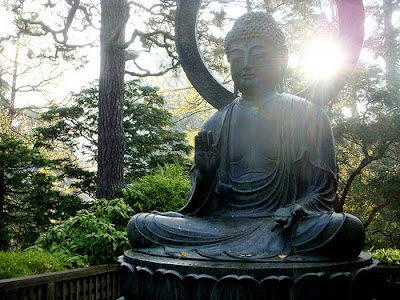
Mahayana Buddha, San Francisco, California (Pineapple.Koolaid)
Theravada Buddha, Saffron Revolution, Burma (BuddhistChannel.TV)
The Dharma, sutras, and commentarial interpretations of interest to American Buddhists of all traditions with news that not only informs but transforms. Emphasis on meditation, enlightenment, karma, social evolution, and nonharming. (To contact us, leave a comment marked "private").


 On Saturday, Dec. 31, 2011, Against the Stream Buddhism Meditation Society will host two (east and west) "intention setting" ceremonial meditations closing out 2011 and welcoming the last year of life on Earth as we know it, 2012. Author and founder Noah Levine and other teachers will be in attendance at both Dharma Punx celebrations.
On Saturday, Dec. 31, 2011, Against the Stream Buddhism Meditation Society will host two (east and west) "intention setting" ceremonial meditations closing out 2011 and welcoming the last year of life on Earth as we know it, 2012. Author and founder Noah Levine and other teachers will be in attendance at both Dharma Punx celebrations. Join in the annual event. Each New Year's Eve a large group gathers to set intentions for the coming year and to re-commit to our spiritual practices. There will be an opportunity to go to the three Buddhist guides (Tri-Sarana), often mistakenly called "refuges," and to undertake Buddhism's Five Precepts anew.
Join in the annual event. Each New Year's Eve a large group gathers to set intentions for the coming year and to re-commit to our spiritual practices. There will be an opportunity to go to the three Buddhist guides (Tri-Sarana), often mistakenly called "refuges," and to undertake Buddhism's Five Precepts anew.
 Been meaning to meditate more or to learn to meditate this year? This is the chance! Everyone is welcome to join in a mini-retreat as we transition from the old to the new year. Come for the entire evening or any part of it. Meditate and celebrate with new friends and fellow readers of Pema Chodron.
Been meaning to meditate more or to learn to meditate this year? This is the chance! Everyone is welcome to join in a mini-retreat as we transition from the old to the new year. Come for the entire evening or any part of it. Meditate and celebrate with new friends and fellow readers of Pema Chodron.
 A newly released DVD of a talk given by Shambhala leader Sakyong Mipham Rinpoche (son of Chogyam Trungpa Rinpoche), "The Awesome Mind: Meditation and the Shambhala Path." He discusses how meditation practice can give the practitioner a handle on the mind and help us orient it the way we want:
A newly released DVD of a talk given by Shambhala leader Sakyong Mipham Rinpoche (son of Chogyam Trungpa Rinpoche), "The Awesome Mind: Meditation and the Shambhala Path." He discusses how meditation practice can give the practitioner a handle on the mind and help us orient it the way we want:
"Our mind is our house. How do we want to arrange it? Do we want more compassion, more focus? Mind is as trainable as body. It has inherent power, clarity, and insight. Mind needs to be related to and respected."
Register to help the coordinators -- especially for those wishing to attend the celebration dinner portion of the evening.
|
*Includes walking meditation. It is not necessary to stay for the entire session; feel free to come and go at any time.
 Arbuda – the "blister" purgatory or hell (naraka). This is a dark, frozen plain surrounded by icy mountains and continually swept by blizzards. Inhabitants of this plane of existence arise fully grown and abide life-long naked and alone, while the cold raises blisters on their bodies. The length of life in this unfortunate realm is said to be the time it would take to empty a barrel of sesame seeds if one only took out a single seed every hundred years.
Arbuda – the "blister" purgatory or hell (naraka). This is a dark, frozen plain surrounded by icy mountains and continually swept by blizzards. Inhabitants of this plane of existence arise fully grown and abide life-long naked and alone, while the cold raises blisters on their bodies. The length of life in this unfortunate realm is said to be the time it would take to empty a barrel of sesame seeds if one only took out a single seed every hundred years.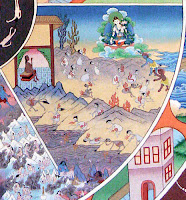 Nirarbuda – the "burst blister" purgatory. This realm is even colder, and here the blisters burst open, leaving the beings' bodies covered with freezing blood and pus.
Nirarbuda – the "burst blister" purgatory. This realm is even colder, and here the blisters burst open, leaving the beings' bodies covered with freezing blood and pus.
 "Everything is burning! What is this 'everything' that is burning? The eye [as well as the other five bases of consciousness -- ear, nose, tongue, body, mind] is burning.
"Everything is burning! What is this 'everything' that is burning? The eye [as well as the other five bases of consciousness -- ear, nose, tongue, body, mind] is burning. "And whatever there is that arises in dependence on contact at the eye -- whether experienced as pleasure, pain, or neither-pleasure-nor-pain -- that too is burning.
"And whatever there is that arises in dependence on contact at the eye -- whether experienced as pleasure, pain, or neither-pleasure-nor-pain -- that too is burning. Nothing hurts more than heartbreak (dukkha), which along with impermanence the Buddha defined as two-thirds of the problem of phenomenal existence (SNL/Celebjihad.com).
Nothing hurts more than heartbreak (dukkha), which along with impermanence the Buddha defined as two-thirds of the problem of phenomenal existence (SNL/Celebjihad.com). In a devastating turn of events, poor Katy Perry (Catty Purry) has been dumped by British comedian Russell Brand after 14 months of marriage to the "ET" songstress. Now as she descends into a funk or a wild acting out spree to compensate for the loss, she is likely to listen to less pop and more trip hop such as Portishead's "Sour Times." What else is she to do without a New Year's Eve date?
In a devastating turn of events, poor Katy Perry (Catty Purry) has been dumped by British comedian Russell Brand after 14 months of marriage to the "ET" songstress. Now as she descends into a funk or a wild acting out spree to compensate for the loss, she is likely to listen to less pop and more trip hop such as Portishead's "Sour Times." What else is she to do without a New Year's Eve date?The Buddha's Advice "O meditators! What is the Noble Truth of suffering (dukkha)? Rebirth is disappointing, aging is disappointing, death is disappointing; sorrow, crying (lamenting), physical pain, grief, and despair are disappointing; associating with the unloved is disappointing; being separated from the loved is disappointing; not getting what one wants is disappointing. In brief, the Five Aggregates of Clinging are disappointing" (SN 56.11).
"O meditators! What is the Noble Truth of suffering (dukkha)? Rebirth is disappointing, aging is disappointing, death is disappointing; sorrow, crying (lamenting), physical pain, grief, and despair are disappointing; associating with the unloved is disappointing; being separated from the loved is disappointing; not getting what one wants is disappointing. In brief, the Five Aggregates of Clinging are disappointing" (SN 56.11).
 The world loves alcohol (and drugs). It loves to check out. There are times when people seek "mind expanding" sacraments and substances (DMT, Iboga, Ayahuasca, mushrooms, LSD, poison toad sweat, cacti, and other entheogens).
The world loves alcohol (and drugs). It loves to check out. There are times when people seek "mind expanding" sacraments and substances (DMT, Iboga, Ayahuasca, mushrooms, LSD, poison toad sweat, cacti, and other entheogens).But most of the time it is about becoming unconscious, careless, negligent, and uninhibited. The Buddha drew out five fundamental actions to abstain from just to be human -- to be reborn in this world or higher.
 They are absolutely fundamental to profitable conduct, to freedom from remorse, and to absorption (jhana), insight (vipassana), mature wisdom (prajna), and enlightenment (bodhi).
They are absolutely fundamental to profitable conduct, to freedom from remorse, and to absorption (jhana), insight (vipassana), mature wisdom (prajna), and enlightenment (bodhi).
One would not think so given the lax attitude towards nearly all of them today. It is important to note that the Buddha did not invent these, nor was he the only one to advocate them. They have a long history he acknowledged.
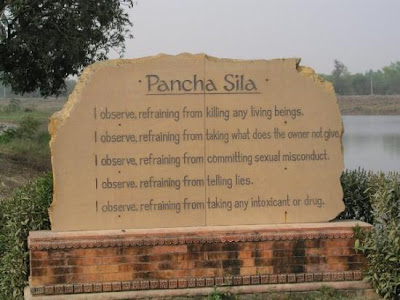 5th Precept: "I vow to undertake to abstain from consuming intoxicants that occasion heedlessness." Sura-meraya-majja-pamadatthana veramani sikkha padam samadiyami.
5th Precept: "I vow to undertake to abstain from consuming intoxicants that occasion heedlessness." Sura-meraya-majja-pamadatthana veramani sikkha padam samadiyami. But he personally verified that holding these precepts led to long term happiness -- freedom from worry and a good rebirth when the karma of holding them comes to fruition. There is a famous saying: "One who upholds the Dharma (the truth) is upheld by the Dharma."
But he personally verified that holding these precepts led to long term happiness -- freedom from worry and a good rebirth when the karma of holding them comes to fruition. There is a famous saying: "One who upholds the Dharma (the truth) is upheld by the Dharma."

 Thus have I heard. One time the Buddha was residing at Jetavana, the monastery donated by Anathapindika, near Savatthi.
Thus have I heard. One time the Buddha was residing at Jetavana, the monastery donated by Anathapindika, near Savatthi.They responded, "Venerable sir!" (They then prepared themselves to hear the following discourse). The Buddha then gave the following instruction on the lunar eight-precept observance (Uposatha).
 "Meditators, the lunar observance is comprised of eight factors observed by the noble disciple. Such observation brings glorious and radiant fruit and benefit. "What is it?"
"Meditators, the lunar observance is comprised of eight factors observed by the noble disciple. Such observation brings glorious and radiant fruit and benefit. "What is it?"
"All of you have given up the taking of liquors and intoxicants. You abstain from drink that causes carelessness. For all of this day and night, in this manner, you will be known as having followed the enlightened ones, and the lunar [sabbath] observance will have been kept by you."
PHOTOS: Five Precept plaque, Lumbini monument (tripadvisor.com); generic alcohol (NPR.org); Buddha as psychedelic hipster on the Eightfold Path (elephantjournal.com); Buddha in copper (Robert Kendall); Hotei, Happy fat Zen Buddha (Ericmichel_def/Flickr.com); traditional depiction of monastics in ancient India with the Buddha; Buddha mind of a psychedelic meditator (Sergiy Kindzerskiy, myspace.com)
 At Vow's Bar in Tokyo, Japan, Buddhist monks run the place and serve up advice along with cocktails. Here a monk -- going against the Buddha's most basic injunctions for lay people (Five Precepts) and for monastics (Vinaya) -- serves alcoholic drinks (Lucy Craft/NPR).
At Vow's Bar in Tokyo, Japan, Buddhist monks run the place and serve up advice along with cocktails. Here a monk -- going against the Buddha's most basic injunctions for lay people (Five Precepts) and for monastics (Vinaya) -- serves alcoholic drinks (Lucy Craft/NPR).  Another Friday night at this tiny neighborhood watering hole in Tokyo: By 7:30 pm, the bar stools and tables in this cozy joint are filling up; office workers settle in with their cocktails and Kirin beers. And by a little after 8:00 pm, it's time for the main act.
Another Friday night at this tiny neighborhood watering hole in Tokyo: By 7:30 pm, the bar stools and tables in this cozy joint are filling up; office workers settle in with their cocktails and Kirin beers. And by a little after 8:00 pm, it's time for the main act. Vow's Bar in the Yotsuya neighborhood has no house band, no widescreen TV, no jukebox. But it does have a chanting Buddhist monk. So tipplers can get a side of sutras with their Singapore Slings or something even more exotic.
 A pair of younger [Japanese Zen] monks -- conspicuous with their shaved heads, bare feet, and religious garb -- man the bar.
A pair of younger [Japanese Zen] monks -- conspicuous with their shaved heads, bare feet, and religious garb -- man the bar.
For a non-Buddhist American like me, they shake up an order of the house specialty, shakunetsu jigoku, or "Burning Hell," and boy, they're not kidding!
This city is said to be honeycombed with 10,000 nightspots, most no bigger than an American living room. So to Japanese, it makes perfect sense that Buddhist monks would run their own themed bars, complete with incense, mandala sacred posters, and religious altars.
 As for the monks themselves, they say that tending bar is, ironically, one of the best ways of connecting with their roots.
As for the monks themselves, they say that tending bar is, ironically, one of the best ways of connecting with their roots.
At the temple, folks are always well-behaved and attentive, no matter how long or boring the sermon is. Here at the bar, [if] they don't like my sermons -- they walk out.
- Gugan Taguchi, head monk [abbot?] at Vow's Bar
"In the old days, temples were the center of community life," says head monk Gugan Taguchi. "But then the temples grew powerful. Monks started getting rich, running funerals. They started to feel superior to their followers. That's not what the job is about." More

 (Nut555/flickr.com; psychicinsights.org)
(Nut555/flickr.com; psychicinsights.org) *The Buddha defined "the world" as the Five Aggregates of Clinging within this "fathom-long" [6 foot long] body, for it is the world we experience, the world we are born into, the world we know in consciousness, the world we cling to, even as these painful and impersonal bodies (forms) and other aggregates go on altering.
*The Buddha defined "the world" as the Five Aggregates of Clinging within this "fathom-long" [6 foot long] body, for it is the world we experience, the world we are born into, the world we know in consciousness, the world we cling to, even as these painful and impersonal bodies (forms) and other aggregates go on altering.


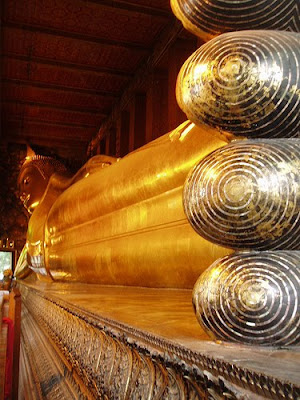
The present-day complex dates back to 1788, having been founded in response to the plundering of the former Thai capital of Ayutthaya by the Burmese in 1767. A similar complex was destroyed at that time and recreated here.
Massage and funny foreigners Wat Pho is a famous place of learning. And instruction is not limited to monastic training. It has a renowned school of Thai massage, which combines Indian Ayurvedic, traditional Chinese medicine, and Southeast Asian innovations.
Wat Pho is a famous place of learning. And instruction is not limited to monastic training. It has a renowned school of Thai massage, which combines Indian Ayurvedic, traditional Chinese medicine, and Southeast Asian innovations.
One enters the complex through gateways guarded by huge Chinese statues, believed to have been imported as ballast aboard ships trading with China. The outer gates have fierce warrior figures, whereas the inner courtyards have the bizarre figures of farang (Western "foreigners") with their peculiar top hats, believed to represent the first European visitors to the East.
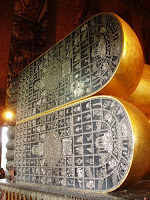 Many of the inner courtyards are surrounded by a cloister containing over 400 sculptures of the seated Buddha. The main bot, the spiritual nucleus of the temple, is beautifully decorated with frescoes of rich landscapes in red and gold.
Many of the inner courtyards are surrounded by a cloister containing over 400 sculptures of the seated Buddha. The main bot, the spiritual nucleus of the temple, is beautifully decorated with frescoes of rich landscapes in red and gold.The biggest and most spectacular attraction of the complex however is the Hall of the Reclining Buddha, housing an enormous gilded figure of the Buddha entering final nirvana. It is over 160 feet long, filling the entire center of the chamber.
Feet, Why Feet? In India and much of Asia, the feet are considered debased and dirty. The brahmins considered the filthiest peeople as being born of the soles of Brahma's feet. But even the lowest parts of a holy person are sacred.
In India and much of Asia, the feet are considered debased and dirty. The brahmins considered the filthiest peeople as being born of the soles of Brahma's feet. But even the lowest parts of a holy person are sacred. These features are not exaggerations or additions. They are documented characteristics that defined one as a World Monarch (chakravartin ruler) or Buddha. What they looked like or how important they are, that indeed is subject to exaggeration.
These features are not exaggerations or additions. They are documented characteristics that defined one as a World Monarch (chakravartin ruler) or Buddha. What they looked like or how important they are, that indeed is subject to exaggeration.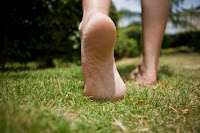 Throughout India and in many Theravada countries (Thailand, Burma, Sri Lanka, Khmer-Empire era Cambodia, etc.), the Buddha's feet are venerated. In Sri Lanka, for example, there is an imprint of the Buddha's foot at the top of Adam's Peak. (It is actually a very large carving). These depictions are embroidered with stories and signs, symbols of fortune and royalty.
Throughout India and in many Theravada countries (Thailand, Burma, Sri Lanka, Khmer-Empire era Cambodia, etc.), the Buddha's feet are venerated. In Sri Lanka, for example, there is an imprint of the Buddha's foot at the top of Adam's Peak. (It is actually a very large carving). These depictions are embroidered with stories and signs, symbols of fortune and royalty.
Watch a depiction of karma as the camera tracks an act of kindness as it passes from one individual to another and manages to boomerang back to the person who set it in motion. Of course, a single deed (karma) done with the intention to benefit or harm a living being has many mental resultants (vipaka) and physical consequences (phala, fruit) when it finally comes to fruition. Acts grow exponentially before their results ripen into our circumstances in this and lives to come. Support lifevestinside.com.

 ...It's no wonder Christian fundamentalists are anti-Hollywood (as this actual handout shows). It's not the sex and violence that really bothers them and gets unbearably under their skin; it's the competition.
...It's no wonder Christian fundamentalists are anti-Hollywood (as this actual handout shows). It's not the sex and violence that really bothers them and gets unbearably under their skin; it's the competition. But it was a two-edged sword: If one is greedy or hateful, the Dark Side rises up and slowly corrupts one. That may have struck a bit too close to home with the film's critics. If one is giving and compassionate, the Light Side does not immediately resolve all one's problems or deficiencies.
But it was a two-edged sword: If one is greedy or hateful, the Dark Side rises up and slowly corrupts one. That may have struck a bit too close to home with the film's critics. If one is giving and compassionate, the Light Side does not immediately resolve all one's problems or deficiencies.








